Relationship Between Child Maltreatment, Self-Esteem, and Religiosity
VerifiedAdded on 2022/10/04
|7
|1694
|21
Report
AI Summary
This report analyzes a study investigating the relationship between child maltreatment, self-esteem, and religious beliefs in young adults. The research explores how different forms of child abuse, including emotional and physical abuse and neglect, correlate with self-esteem levels and views of God (e.g., God as punishing or benevolent). The study uses correlational experiments, questionnaires, and statistical analyses to examine the impact of interpersonal issues and religiosity as mediators in this relationship. The findings suggest that emotional abuse and neglect are significant predictors of lower self-esteem and negative views of God, while physical abuse may have less impact. The report highlights the study's methodology, limitations, and conclusions, offering insights into the psychological effects of child maltreatment and the role of religious beliefs in the healing process. The report concludes with a positive assessment of the study's strengths and potential implications for therapeutic interventions and religious organizations.
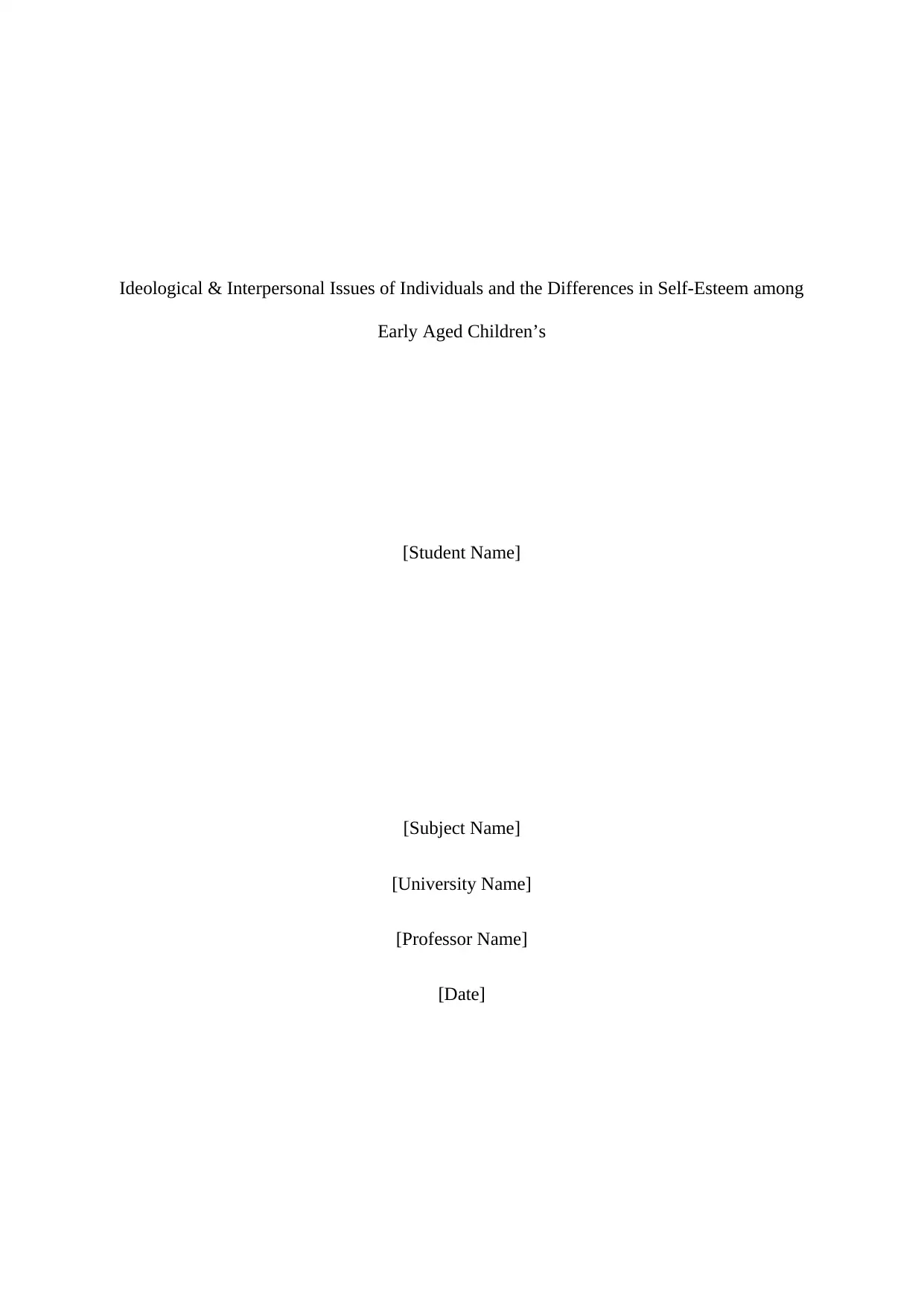
Ideological & Interpersonal Issues of Individuals and the Differences in Self-Esteem among
Early Aged Children’s
[Student Name]
[Subject Name]
[University Name]
[Professor Name]
[Date]
Early Aged Children’s
[Student Name]
[Subject Name]
[University Name]
[Professor Name]
[Date]
Paraphrase This Document
Need a fresh take? Get an instant paraphrase of this document with our AI Paraphraser

The main aim of this study is to find out how children that have been maltreated view
god in later life. The dependent variable for this research is interpersonally and religiosity, as
it is something we are measuring and their independent variable, is different forms of child
maltreatment as that’s what their condition is. Their research hypothesis is that people that
have been child abused in the past and are low in self-esteem has negative view of God (God
is punishing) whilst some theorists may disagree with this as they believe people that are
being maltreated pray more and ask god for help. Their hypothesis anticipated different types
of child abuse and neglect to predict reduced self-esteem for adults and to explain this
connection by individual differences in interpersonal issues and religiosity (believing in god).
This paper is distinct from earlier studies as there are not many studies involving finding
child trauma and self-esteem in relation to the divine god so this fresh research study as prior
study only outlined the advantages of believing in the divine god while this study looks at the
opinions of god in kids after being abused and neglected.
Waldron et al. used questionnaires to measure childhood trauma. The children's age is
from 5 to 10. At a large university located in Chester, the questionnaires that were created by
the university was been distributed among young females. There was a total of 718 women
who took part in it. These women were asked about their nationality and their religion and to
fill out a questionnaire. In the questionnaires they also asked question on religiosity and
spitefulness, interpersonal issues and self-esteem scales. It took them half an hour to
complete the full questionnaires so they were encouraged to take breaks in between. The
questionnaires were done online. This research method was done using correlational
experiments which means exploring and observing variables, which in this case is the view of
God after child traumatic incident so therefore these research designs are suitable for the
questions that are asked in the study. This is a very big sample and therefore you can
generalise to the whole population however it is only done with the people that go university
god in later life. The dependent variable for this research is interpersonally and religiosity, as
it is something we are measuring and their independent variable, is different forms of child
maltreatment as that’s what their condition is. Their research hypothesis is that people that
have been child abused in the past and are low in self-esteem has negative view of God (God
is punishing) whilst some theorists may disagree with this as they believe people that are
being maltreated pray more and ask god for help. Their hypothesis anticipated different types
of child abuse and neglect to predict reduced self-esteem for adults and to explain this
connection by individual differences in interpersonal issues and religiosity (believing in god).
This paper is distinct from earlier studies as there are not many studies involving finding
child trauma and self-esteem in relation to the divine god so this fresh research study as prior
study only outlined the advantages of believing in the divine god while this study looks at the
opinions of god in kids after being abused and neglected.
Waldron et al. used questionnaires to measure childhood trauma. The children's age is
from 5 to 10. At a large university located in Chester, the questionnaires that were created by
the university was been distributed among young females. There was a total of 718 women
who took part in it. These women were asked about their nationality and their religion and to
fill out a questionnaire. In the questionnaires they also asked question on religiosity and
spitefulness, interpersonal issues and self-esteem scales. It took them half an hour to
complete the full questionnaires so they were encouraged to take breaks in between. The
questionnaires were done online. This research method was done using correlational
experiments which means exploring and observing variables, which in this case is the view of
God after child traumatic incident so therefore these research designs are suitable for the
questions that are asked in the study. This is a very big sample and therefore you can
generalise to the whole population however it is only done with the people that go university
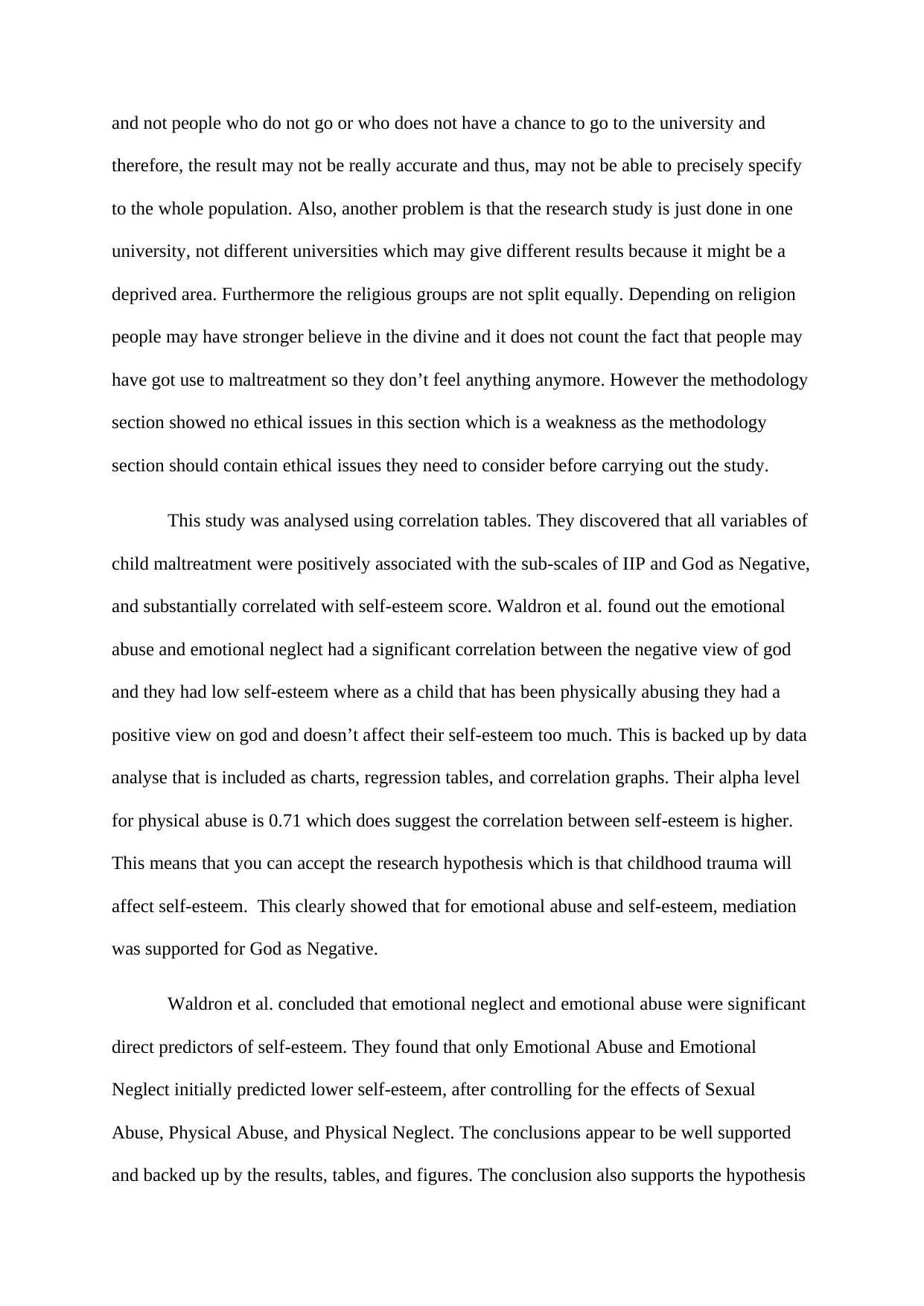
and not people who do not go or who does not have a chance to go to the university and
therefore, the result may not be really accurate and thus, may not be able to precisely specify
to the whole population. Also, another problem is that the research study is just done in one
university, not different universities which may give different results because it might be a
deprived area. Furthermore the religious groups are not split equally. Depending on religion
people may have stronger believe in the divine and it does not count the fact that people may
have got use to maltreatment so they don’t feel anything anymore. However the methodology
section showed no ethical issues in this section which is a weakness as the methodology
section should contain ethical issues they need to consider before carrying out the study.
This study was analysed using correlation tables. They discovered that all variables of
child maltreatment were positively associated with the sub-scales of IIP and God as Negative,
and substantially correlated with self-esteem score. Waldron et al. found out the emotional
abuse and emotional neglect had a significant correlation between the negative view of god
and they had low self-esteem where as a child that has been physically abusing they had a
positive view on god and doesn’t affect their self-esteem too much. This is backed up by data
analyse that is included as charts, regression tables, and correlation graphs. Their alpha level
for physical abuse is 0.71 which does suggest the correlation between self-esteem is higher.
This means that you can accept the research hypothesis which is that childhood trauma will
affect self-esteem. This clearly showed that for emotional abuse and self-esteem, mediation
was supported for God as Negative.
Waldron et al. concluded that emotional neglect and emotional abuse were significant
direct predictors of self-esteem. They found that only Emotional Abuse and Emotional
Neglect initially predicted lower self-esteem, after controlling for the effects of Sexual
Abuse, Physical Abuse, and Physical Neglect. The conclusions appear to be well supported
and backed up by the results, tables, and figures. The conclusion also supports the hypothesis
therefore, the result may not be really accurate and thus, may not be able to precisely specify
to the whole population. Also, another problem is that the research study is just done in one
university, not different universities which may give different results because it might be a
deprived area. Furthermore the religious groups are not split equally. Depending on religion
people may have stronger believe in the divine and it does not count the fact that people may
have got use to maltreatment so they don’t feel anything anymore. However the methodology
section showed no ethical issues in this section which is a weakness as the methodology
section should contain ethical issues they need to consider before carrying out the study.
This study was analysed using correlation tables. They discovered that all variables of
child maltreatment were positively associated with the sub-scales of IIP and God as Negative,
and substantially correlated with self-esteem score. Waldron et al. found out the emotional
abuse and emotional neglect had a significant correlation between the negative view of god
and they had low self-esteem where as a child that has been physically abusing they had a
positive view on god and doesn’t affect their self-esteem too much. This is backed up by data
analyse that is included as charts, regression tables, and correlation graphs. Their alpha level
for physical abuse is 0.71 which does suggest the correlation between self-esteem is higher.
This means that you can accept the research hypothesis which is that childhood trauma will
affect self-esteem. This clearly showed that for emotional abuse and self-esteem, mediation
was supported for God as Negative.
Waldron et al. concluded that emotional neglect and emotional abuse were significant
direct predictors of self-esteem. They found that only Emotional Abuse and Emotional
Neglect initially predicted lower self-esteem, after controlling for the effects of Sexual
Abuse, Physical Abuse, and Physical Neglect. The conclusions appear to be well supported
and backed up by the results, tables, and figures. The conclusion also supports the hypothesis
⊘ This is a preview!⊘
Do you want full access?
Subscribe today to unlock all pages.

Trusted by 1+ million students worldwide
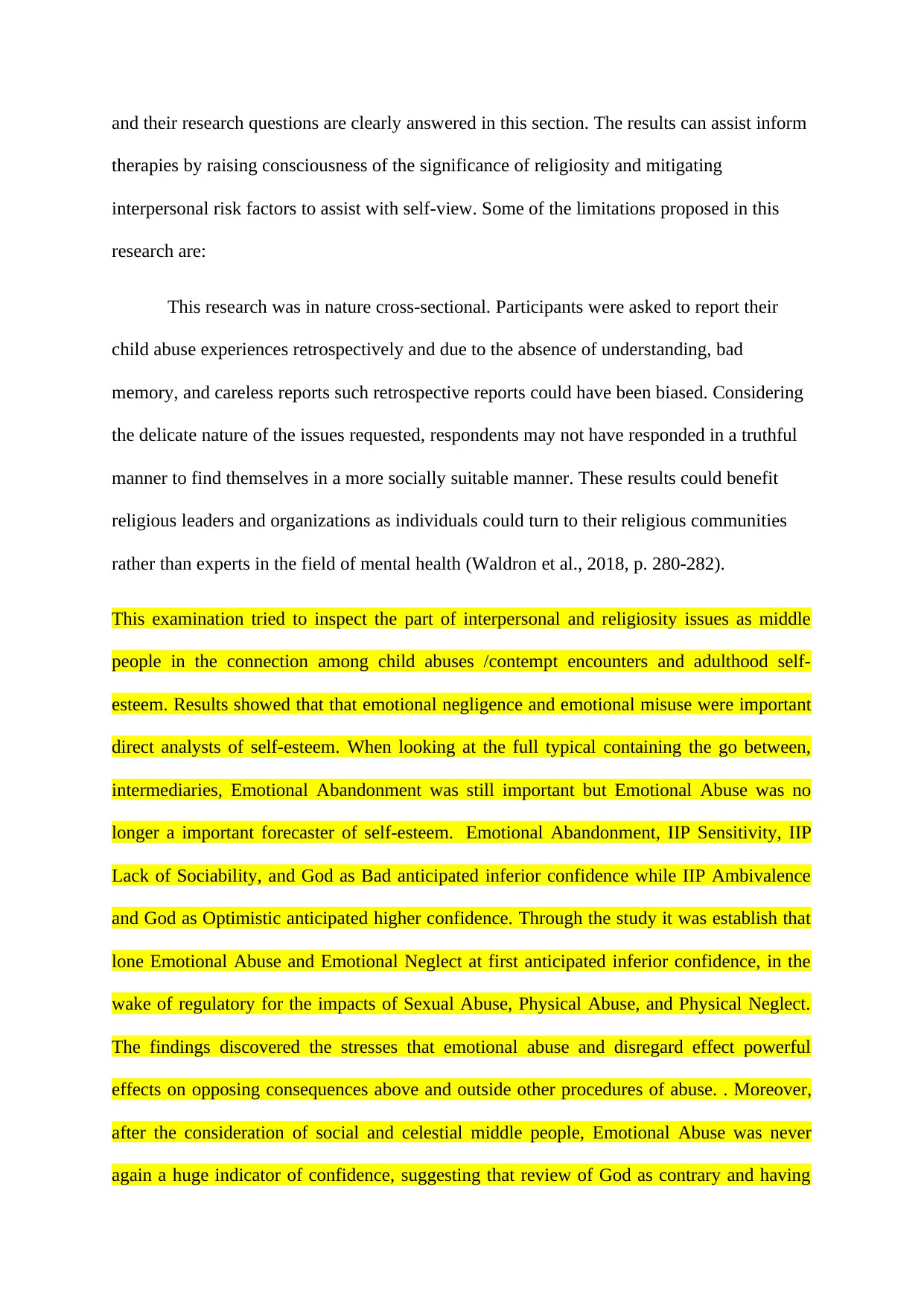
and their research questions are clearly answered in this section. The results can assist inform
therapies by raising consciousness of the significance of religiosity and mitigating
interpersonal risk factors to assist with self-view. Some of the limitations proposed in this
research are:
This research was in nature cross-sectional. Participants were asked to report their
child abuse experiences retrospectively and due to the absence of understanding, bad
memory, and careless reports such retrospective reports could have been biased. Considering
the delicate nature of the issues requested, respondents may not have responded in a truthful
manner to find themselves in a more socially suitable manner. These results could benefit
religious leaders and organizations as individuals could turn to their religious communities
rather than experts in the field of mental health (Waldron et al., 2018, p. 280-282).
This examination tried to inspect the part of interpersonal and religiosity issues as middle
people in the connection among child abuses /contempt encounters and adulthood self-
esteem. Results showed that that emotional negligence and emotional misuse were important
direct analysts of self-esteem. When looking at the full typical containing the go between,
intermediaries, Emotional Abandonment was still important but Emotional Abuse was no
longer a important forecaster of self-esteem. Emotional Abandonment, IIP Sensitivity, IIP
Lack of Sociability, and God as Bad anticipated inferior confidence while IIP Ambivalence
and God as Optimistic anticipated higher confidence. Through the study it was establish that
lone Emotional Abuse and Emotional Neglect at first anticipated inferior confidence, in the
wake of regulatory for the impacts of Sexual Abuse, Physical Abuse, and Physical Neglect.
The findings discovered the stresses that emotional abuse and disregard effect powerful
effects on opposing consequences above and outside other procedures of abuse. . Moreover,
after the consideration of social and celestial middle people, Emotional Abuse was never
again a huge indicator of confidence, suggesting that review of God as contrary and having
therapies by raising consciousness of the significance of religiosity and mitigating
interpersonal risk factors to assist with self-view. Some of the limitations proposed in this
research are:
This research was in nature cross-sectional. Participants were asked to report their
child abuse experiences retrospectively and due to the absence of understanding, bad
memory, and careless reports such retrospective reports could have been biased. Considering
the delicate nature of the issues requested, respondents may not have responded in a truthful
manner to find themselves in a more socially suitable manner. These results could benefit
religious leaders and organizations as individuals could turn to their religious communities
rather than experts in the field of mental health (Waldron et al., 2018, p. 280-282).
This examination tried to inspect the part of interpersonal and religiosity issues as middle
people in the connection among child abuses /contempt encounters and adulthood self-
esteem. Results showed that that emotional negligence and emotional misuse were important
direct analysts of self-esteem. When looking at the full typical containing the go between,
intermediaries, Emotional Abandonment was still important but Emotional Abuse was no
longer a important forecaster of self-esteem. Emotional Abandonment, IIP Sensitivity, IIP
Lack of Sociability, and God as Bad anticipated inferior confidence while IIP Ambivalence
and God as Optimistic anticipated higher confidence. Through the study it was establish that
lone Emotional Abuse and Emotional Neglect at first anticipated inferior confidence, in the
wake of regulatory for the impacts of Sexual Abuse, Physical Abuse, and Physical Neglect.
The findings discovered the stresses that emotional abuse and disregard effect powerful
effects on opposing consequences above and outside other procedures of abuse. . Moreover,
after the consideration of social and celestial middle people, Emotional Abuse was never
again a huge indicator of confidence, suggesting that review of God as contrary and having
Paraphrase This Document
Need a fresh take? Get an instant paraphrase of this document with our AI Paraphraser
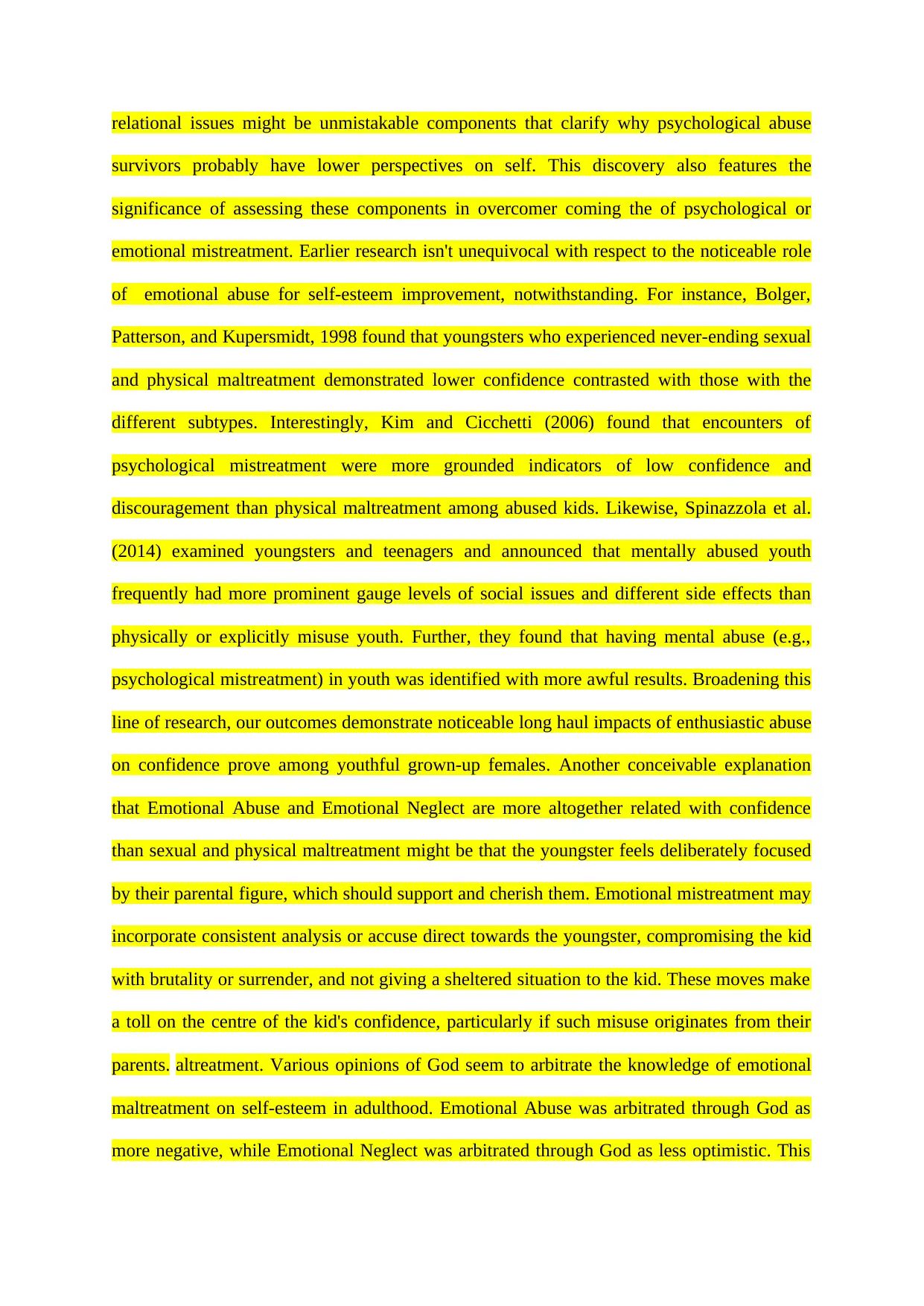
relational issues might be unmistakable components that clarify why psychological abuse
survivors probably have lower perspectives on self. This discovery also features the
significance of assessing these components in overcomer coming the of psychological or
emotional mistreatment. Earlier research isn't unequivocal with respect to the noticeable role
of emotional abuse for self-esteem improvement, notwithstanding. For instance, Bolger,
Patterson, and Kupersmidt, 1998 found that youngsters who experienced never-ending sexual
and physical maltreatment demonstrated lower confidence contrasted with those with the
different subtypes. Interestingly, Kim and Cicchetti (2006) found that encounters of
psychological mistreatment were more grounded indicators of low confidence and
discouragement than physical maltreatment among abused kids. Likewise, Spinazzola et al.
(2014) examined youngsters and teenagers and announced that mentally abused youth
frequently had more prominent gauge levels of social issues and different side effects than
physically or explicitly misuse youth. Further, they found that having mental abuse (e.g.,
psychological mistreatment) in youth was identified with more awful results. Broadening this
line of research, our outcomes demonstrate noticeable long haul impacts of enthusiastic abuse
on confidence prove among youthful grown-up females. Another conceivable explanation
that Emotional Abuse and Emotional Neglect are more altogether related with confidence
than sexual and physical maltreatment might be that the youngster feels deliberately focused
by their parental figure, which should support and cherish them. Emotional mistreatment may
incorporate consistent analysis or accuse direct towards the youngster, compromising the kid
with brutality or surrender, and not giving a sheltered situation to the kid. These moves make
a toll on the centre of the kid's confidence, particularly if such misuse originates from their
parents. altreatment. Various opinions of God seem to arbitrate the knowledge of emotional
maltreatment on self-esteem in adulthood. Emotional Abuse was arbitrated through God as
more negative, while Emotional Neglect was arbitrated through God as less optimistic. This
survivors probably have lower perspectives on self. This discovery also features the
significance of assessing these components in overcomer coming the of psychological or
emotional mistreatment. Earlier research isn't unequivocal with respect to the noticeable role
of emotional abuse for self-esteem improvement, notwithstanding. For instance, Bolger,
Patterson, and Kupersmidt, 1998 found that youngsters who experienced never-ending sexual
and physical maltreatment demonstrated lower confidence contrasted with those with the
different subtypes. Interestingly, Kim and Cicchetti (2006) found that encounters of
psychological mistreatment were more grounded indicators of low confidence and
discouragement than physical maltreatment among abused kids. Likewise, Spinazzola et al.
(2014) examined youngsters and teenagers and announced that mentally abused youth
frequently had more prominent gauge levels of social issues and different side effects than
physically or explicitly misuse youth. Further, they found that having mental abuse (e.g.,
psychological mistreatment) in youth was identified with more awful results. Broadening this
line of research, our outcomes demonstrate noticeable long haul impacts of enthusiastic abuse
on confidence prove among youthful grown-up females. Another conceivable explanation
that Emotional Abuse and Emotional Neglect are more altogether related with confidence
than sexual and physical maltreatment might be that the youngster feels deliberately focused
by their parental figure, which should support and cherish them. Emotional mistreatment may
incorporate consistent analysis or accuse direct towards the youngster, compromising the kid
with brutality or surrender, and not giving a sheltered situation to the kid. These moves make
a toll on the centre of the kid's confidence, particularly if such misuse originates from their
parents. altreatment. Various opinions of God seem to arbitrate the knowledge of emotional
maltreatment on self-esteem in adulthood. Emotional Abuse was arbitrated through God as
more negative, while Emotional Neglect was arbitrated through God as less optimistic. This
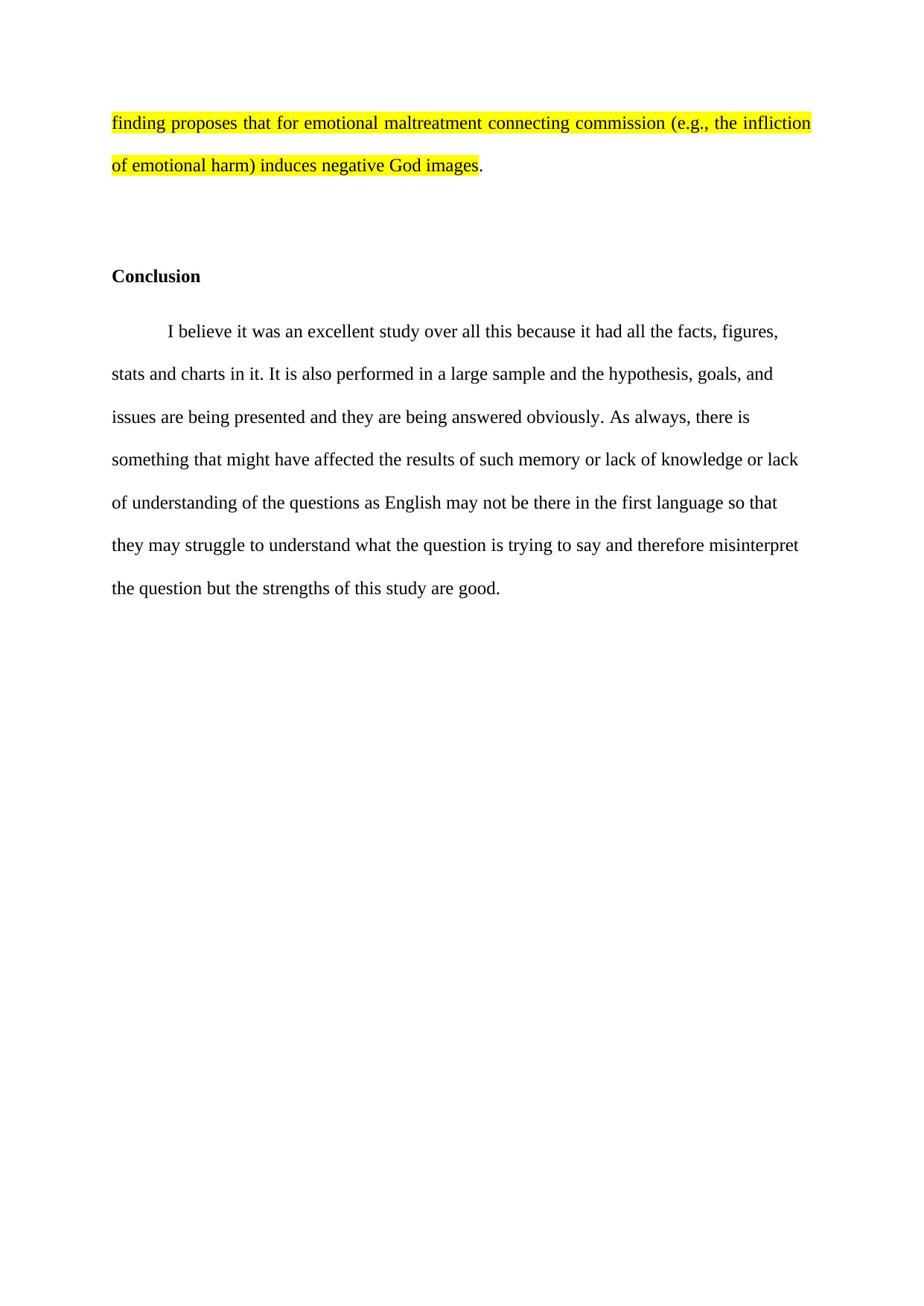
finding proposes that for emotional maltreatment connecting commission (e.g., the infliction
of emotional harm) induces negative God images.
Conclusion
I believe it was an excellent study over all this because it had all the facts, figures,
stats and charts in it. It is also performed in a large sample and the hypothesis, goals, and
issues are being presented and they are being answered obviously. As always, there is
something that might have affected the results of such memory or lack of knowledge or lack
of understanding of the questions as English may not be there in the first language so that
they may struggle to understand what the question is trying to say and therefore misinterpret
the question but the strengths of this study are good.
of emotional harm) induces negative God images.
Conclusion
I believe it was an excellent study over all this because it had all the facts, figures,
stats and charts in it. It is also performed in a large sample and the hypothesis, goals, and
issues are being presented and they are being answered obviously. As always, there is
something that might have affected the results of such memory or lack of knowledge or lack
of understanding of the questions as English may not be there in the first language so that
they may struggle to understand what the question is trying to say and therefore misinterpret
the question but the strengths of this study are good.
⊘ This is a preview!⊘
Do you want full access?
Subscribe today to unlock all pages.

Trusted by 1+ million students worldwide

References
Waldron, J., Scarpa, A., & Kim-Spoon, J. (2018). Religiosity and interpersonal problems
explain individual differences in self-esteem among young adults with child
maltreatment experiences. Child Abuse & Neglect, 80, 277-284. doi:
10.1016/j.chiabu.2018.03.023
Waldron, J., Scarpa, A., & Kim-Spoon, J. (2018). Religiosity and interpersonal problems
explain individual differences in self-esteem among young adults with child
maltreatment experiences. Child Abuse & Neglect, 80, 277-284. doi:
10.1016/j.chiabu.2018.03.023
1 out of 7
Your All-in-One AI-Powered Toolkit for Academic Success.
+13062052269
info@desklib.com
Available 24*7 on WhatsApp / Email
![[object Object]](/_next/static/media/star-bottom.7253800d.svg)
Unlock your academic potential
Copyright © 2020–2025 A2Z Services. All Rights Reserved. Developed and managed by ZUCOL.


